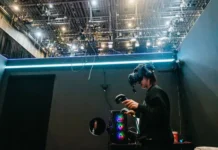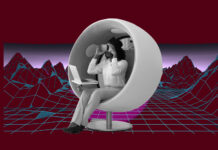Everything you never wanted to know about the future of talking about the future.
TO HEAR TECH CEOs like Mark Zuckerberg or Satya Nadella talk about it, the metaverse is the future of the internet. Or it’s a video game. Or maybe it’s a deeply uncomfortable, worse version of Zoom? It’s hard to say.
To a certain extent, talking about what “the metaverse” means is a bit like having a discussion about what “the internet” means in the 1970s. The building blocks of a new form of communication were in the process of being built, but no one could really know what the reality would look like. So while it was true, at the time, that “the internet” was coming, not every idea of what that would look like is true.
On the other hand, there’s also a lot of marketing hype wrapped up in this idea of the metaverse. Facebook, in particular, is in an especially vulnerable place after Apple’s move to limit ad tracking hit the company’s bottom line. It’s impossible to separate Facebook’s vision of a future where everyone has a digital wardrobe to swipe through from the fact that Facebook really wants to make money selling virtual clothes.
So, with all that in mind …
Seriously, What Does ‘Metaverse’ Mean?
To help you get a sense of how vague and complex a term “the metaverse” can be, here’s an exercise to try: Mentally replace the phrase “the metaverse” in a sentence with “cyberspace.” Ninety percent of the time, the meaning won’t substantially change. That’s because the term doesn’t really refer to any one specific type of technology, but rather a broad shift in how we interact with technology. And it’s entirely possible that the term itself will eventually become just as antiquated, even as the specific technology it once described becomes commonplace.
Broadly speaking, the technologies that make up the metaverse can include virtual reality—characterized by persistent virtual worlds that continue to exist even when you’re not playing—as well as augmented reality that combines aspects of the digital and physical worlds. However, it doesn’t require that those spaces be exclusively accessed via VR or AR. A virtual world, like aspects of Fortnite that can be accessed through PCs, game consoles, and even phones, could be metaversal.
It also translates to a digital economy, where users can create, buy, and sell goods. And, in the more idealistic visions of the metaverse, it’s interoperable, allowing you to take virtual items like clothes or cars from one platform to another. In the real world, you can buy a shirt from the mall and then wear it to a movie theater. Right now, most platforms have virtual identities, avatars, and inventories that are tied to just one platform, but a metaverse might allow you to create a persona that you can take everywhere as easily as you can copy your profile picture from one social network to another.
It’s difficult to parse what all this means because when you hear descriptions like those above, an understandable response is, “Wait, doesn’t that exist already?” World of Warcraft, for example, is a persistent virtual world where players can buy and sell goods. Fortnite has virtual experiences like concerts and an exhibit where Rick Sanchez can learn about MLK Jr. You can strap on an Oculus headset and be in your own personal virtual home. Is that really what “the metaverse” means? Just some new kinds of video games?
Well, yes and no. Saying that Fortnite is “the metaverse” would be a bit like saying Google is “the internet.” Even if you could, theoretically, spend large chunks of time in Fortnite, socializing, buying things, learning, and playing games, that doesn’t necessarily mean that it encompasses the entire scope of the metaverse.
On the other hand, just as it would be accurate to say that Google builds parts of the internet—from physical data centers to security layers—it’s similarly accurate to say that Fortnite creator Epic Games is building parts of the metaverse. And it isn’t the only company doing so. Some of that work will be done by tech giants like Microsoft and Facebook—the latter of which recently rebranded to Meta to reflect this work, though we’re still not quite used to the name. Many other assorted companies—including Nvidia, Unity, Roblox, and even Snap—are all working on building the infrastructure that might become the metaverse.
It’s at this point that most discussions of what the metaverse entails start to stall. We have a vague sense of what things currently exist that we could kind of call the metaverse, and we know which companies are investing in the idea, but we still don’t know what it is. Facebook—sorry, Meta, still not getting it—thinks it will include fake houses you can invite all your friends to hang out in. Microsoft seems to think it could involve virtual meeting rooms to train new hires or chat with your remote coworkers.
The pitches for these visions of the future range from optimistic to outright fan fiction. At one point during … Meta’s … presentation on the metaverse, the company showed a scenario in which a young woman is sitting on her couch scrolling through Instagram when she sees a video a friend posted of a concert that’s happening halfway across the world.
The video then cuts to the concert, where the woman appears in an Avengers-style hologram. She’s able to make eye contact with her friend who is physically there, they’re both able to hear the concert, and they can see floating text hovering above the stage. This seems cool, but it’s not really advertising a real product, or even a possible future one. In fact, it brings us to the biggest problem with “the metaverse.”
Why Does the Metaverse Involve Holograms?
When the internet first arrived, it started with a series of technological innovations, like the ability to let computers talk to each other over great distances or the ability to hyperlink from one web page to another. These technical features were the building blocks that were then used to make the abstract structures we know the internet for: websites, apps, social networks, and everything else that relies on those core elements. And that’s to say nothing of the convergence of the interface innovations that aren’t strictly part of the internet but are still necessary to make it work, such as displays, keyboards, mice, and touchscreens.
With the metaverse, there are some new building blocks in place, like the ability to host hundreds of people in a single instance of a server (ideally future versions of a metaverse will be able to handle thousands or even millions of people at once), or motion-tracking tools that can distinguish where a person is looking or where their hands are. These new technologies can be very exciting and feel futuristic.
However, there are limitations that may be impossible to overcome. When tech companies like Microsoft or Fa—Meta show fictionalized videos of their visions of the future, they frequently tend to gloss over just how people will interact with the metaverse. VR headsets are still very clunky, and most people experience motion sickness or physical pain if they wear them for too long. Augmented reality glasses face a similar problem, on top of the not-insignificant issue of figuring out how people can wear them around in public without looking like huge dorks.
So, how do tech companies show off the idea of their technology without showing the reality of bulky headsets and dorky glasses? So far their primary solution seems to be to simply fabricate technology from whole cloth. The holographic woman from Meta’s presentation? I hate to shatter the illusion, but it’s simply not possible with even very advanced versions of existing technology.
Unlike motion-tracked digital avatars, which are kind of janky right now but could be better someday, there’s no janky version of making a three-dimensional picture appear in midair without tightly controlled circumstances. No matter what Iron Man tells you. Perhaps these are meant to be interpreted as images projected via glasses—both women in the demo video are wearing similar glasses, after all—but even that assumes a lot about the physical capabilities of compact glasses, which Snap can tell you isn’t a simple problem to solve.
This kind of glossing over reality is frequently present in video demos of how the metaverse could work. Another of Meta’s demos showed characters floating in space—is this person strapped to an immersive aerial rig or are they just sitting at a desk? A person represented by a hologram—does this person have a headset on, and if so how is their face being scanned? And at points, a person grabs virtual items but then holds those objects in what seems to be their physical hands.
This demo raises so many more questions than it answers.
On some level, this is fine. Microsoft, Meta, and every other company that shows wild demos like this are trying to give an artistic impression of what the future could be, not necessarily account for every technical question. It’s a time-honored tradition going back to AT&T’s demo of a voice-controlled foldable phone that could magically erase people from images and generate 3D models, all of which might’ve seemed similarly impossible at the time.
However, this kind of wishful-thinking-as-tech-demo leaves us in a place where it’s hard to pinpoint which aspects of the various visions of the metaverse will actually be real one day. If VR and AR headsets become comfortable and cheap enough for people to wear on a daily basis—a substantial “if”—then perhaps the idea of a virtual poker game where your friends are robots and holograms and floating in space could be somewhat close to reality. If not, well you could always play Tabletop Simulator on a Discord video call.
The flashiness of VR and AR also obscure the more mundane aspects of the metaverse that might be more likely to come to fruition. It would be trivially easy for tech companies to invent, say, an open digital avatar standard, a type of file that includes characteristics you might enter into a character creator—like eye color, hairstyle, or clothing options—and let you take it everywhere. There’s no need to build a more comfortable VR headset for that.
But that’s not as fun to imagine.
What’s the Metaverse Like Right Now?
The paradox of defining the metaverse is that in order for it to be the future, you have to define away the present. We already have MMOs that are essentially entire virtual worlds, digital concerts, video calls with people from all over the world, online avatars, and commerce platforms. So in order to sell these things as a new vision of the world, there has to be some element of it that’s new.
Spend enough time having discussions about the metaverse and inevitably someone will reference fictional stories like Snow Crash—the 1992 novel that coined the term “metaverse”—or Ready Player One, which depicts a VR world where everyone works, plays, and shops. Combined with the general pop culture idea of holograms and heads-up displays (basically anything Iron Man has used in his last 10 movies) these stories serve as an imaginative reference point for what the metaverse—a metaverse that tech companies could actually sell as something new—could look like.
Mentally replace the phrase “the metaverse” in a sentence with “cyberspace.” Ninety percent of the time, the meaning won’t substantially change.
That kind of hype is as vital a part of the idea of the metaverse as any other. It’s no wonder, then, that people promoting things like NFTs—cryptographic tokens that can serve as certificates of ownership of a digital item, sort of—are also latching onto the idea of the metaverse. Sure, NFTs are bad for the environment, but if it could be argued that these tokens might be the digital key to your virtual mansion in Roblox, then boom. You’ve just transformed your hobby of buying memes into a crucial piece of infrastructure for the future of the internet (and possibly raised the value of all that cryptocurrency you’re holding.)
It’s important to keep all this context in mind because while it’s tempting to compare the proto-metaverse ideas we have today to the early internet and assume everything will get better and progress in a linear fashion, that’s not a given. There’s no guarantee people will even want to hang out sans legs in a virtual office or play poker with Dreamworks Mark Zuckerberg, much less whether VR and AR tech will ever become seamless enough to be as common as smartphones and computers are today.
It may even be the case that any real “metaverse” would be little more than some cool VR games and digital avatars in Zoom calls, but mostly just something we still think of as the internet.























































